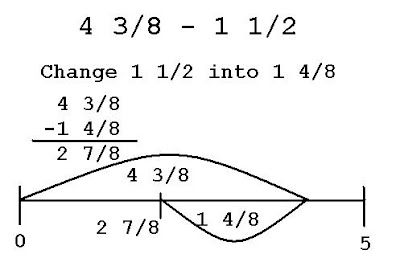Yesterday at school we reviewed subtracted fractions and the
different strategies used to answer them. The Strategies that were used were double number lines, money, clocks, and common denominators.
Our homework was to use 3
different strategies for 4 fraction questions.
The questions are 1) 2 1/5 - 3/10, 2) 3 1/4 - 5/8, 3) 1 2/3 - 7/12, 4) 6/7 - 4/11

In this example i found out a common denominator both denominators went in to and
10 was a simple one. When changing the 5 to 10 x2 you multiply the 1 by 2 to get 2 you have to do the same to both numbers of a fraction. getting that u cant take 3 away from 2 so i had to borrow from my whole. so instead of 2 wholes i had 1 and now had a numerator of 12. 12 - 3 = 9 1-0 = 1 so
1 9/10.

This example shows a common
denominator again. To get my common denominator i multiplied 7x11 and got 77 i divided 77 by 7 and 11. to get 11 and 7 this is so i know how much to multiply my numerator. From that i multiplied 11x 6
because i x the denominator by 11 then 7x4
because i multiplied that denominator by 7. from multiplying i got 28 (4x7) and 66 (6x11). then 28-66 is 38. 38 over 77

Just to change it up for now i did this one in clocks. in my example the filled in red circle is 60 minutes the whole. as u can see in my next clock
isnt the best coloring but it does the job shows that 2/3 is 40 minutes. Then my other clock shows 7/12, i divided 12 by 60 to get 5 then multiplied it by 7 to get 35 minutes. Then i subtracted. 40-35=5 minutes.
Since the whole (1)
wasnt borrowed or had to subtract another whole you
dont need to change it.

I took long in making my other examples to be more explainable that i did this one quick. This one is easy to do common
denominator because 4 goes into 8 2 times, since i x2 to the
denominator i do the same to
numerator and get 2 i am not able to take 5 away from 2 so i borrowed the whole to make a numerator to equal 12 then took away 5 to get 7. my answer is then 2 7/8.



























